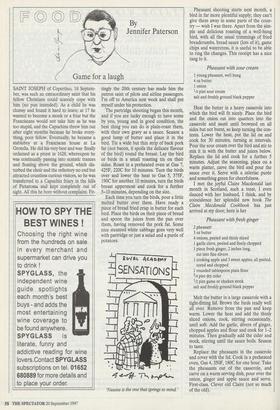SAINT JOSEPH of Copertino, 18 Septem- ber, was such an
extraordinary saint that his fellow Christians could scarcely cope with him (no pun intended). As a child he was clumsy and found it hard to learn; at 17 he wanted to become a monk or a friar but the Franciscans would not take him as he was too stupid, and the Capuchins threw him out after eight months because he broke every- thing, poor fellow. Eventually, he became a stableboy at a Franciscan house at La Grotella. He did his very best and was finally ordained as a priest in 1628, whereupon he was continually passing into ecstatic trances and floating above the ground, which dis- turbed the choir and the refectory no end but attracted countless curious visitors, so he was transferred to a Capuchin friary in the hills of Pietarossa and kept completely out of sight. All this he bore without complaint. Fit- tingly the 20th century has made him the patron saint of pilots and airline passengers. I'm off to America next week and shall put myself under his protection.
The partridge shooting began this month, and if you are lucky enough to have some by you, young and in good condition, the best thing you can do is plain-roast them, with their own gravy as a sauce. Season a good lump of butter and place it in the bird. Tie a wide but thin strip of back pork fat (not bacon, it spoils the delicate flavour of the bird) round the breast. Lay the bird or birds in a small roasting tin on their sides. Roast in a preheated oven at Gas 7, 425F, 220C for 10 minutes. Turn the birds over and lower the heat to Gas 5, 375F, 190C for another 10 minutes, turn the birds breast uppermost and cook for a further 5-10 minutes, depending on the size.
Each time you turn the birds, pour a little melted butter over them. Have ready a piece of bread fried crisp in butter for each bird. Place the birds on their piece of bread and spoon the juices from the pan over them, having removed the pork fat. Some nice steamed white cabbage goes very well with partridge or just a salad and a purée of potatoes.
Nausea is the one that springs to mind.' Pheasant shooting starts next month, a bird in far more plentiful supply; they can't give them away in some parts of the coun- try — wish I was there. Apart from the sim- ple and delicious roasting of a well-hung bird, with all the usual trimmings of fried breadcrumbs, bread sauce (lots of it), game chips and watercress, it is useful to be able to ring the changes. This receipt has a nice tang to it.
Pheasant with sour cream
1 young pheasant, well hung 4 oz butter 1 onion
1/4 pint sour cream
salt and freshly ground black pepper Heat the butter in a heavy casserole into which the bird will fit nicely. Place the bird and the onion cut into quarters into the casserole and saute until browned on all sides but not burnt, so keep turning the con- tents. Lower the heat, put the lid on and cook for 30 minutes, turning at intervals. Pour the sour cream over the bird and stir to mix it in with the butter and juices below. Replace the lid and cook for a further 5 minutes. Adjust the seasoning, place on a warm platter, carve the bird and pour the sauce over it. Serve with a celeriac purée and something green for cheerfulness.
I met the joyful Claire Macdonald last month in Scotland, such a treat, I even danced with her husband, I think, and by coincidence her splendid new book The Claire Macdonald Cookbook has just arrived at my door; here is her Pheasant with fresh ginger
2 pheasant 3 oz butter 4 onions, peeled and thinly sliced 1 garlic clove, peeled and finely chopped 1 piece fresh ginger, 2 inches long, cut into fine slivers 1 cooking apple and 3 sweet apples, all peeled, cored and chopped 1 rounded tablespoon plain flour
3/4 pint dry cider 1/2 pint game or chicken stock
salt and freshly ground black pepper Melt the butter in a large casserole with a tight-fitting lid. Brown the birds really well all over. Remove from the pan and keep warm. Lower the heat and add the thinly sliced onions, cook, stirring occasionally, until soft. Add the garlic, slivers of ginger, chopped apples and flour and cook for 1-2 minutes. Then gradually add the cider and stock, stirring until the sauce boils. Season to taste.
Replace the pheasants in the casserole and cover with the lid. Cook in a preheated oven, Gas 4, 350F, 180C for one hour. Take the pheasants out of the casserole, and carve on a warm serving dish, pour over the onion, ginger and apple sauce and serve. First-class. Clever old Claire (not so much of the old).


































































 Previous page
Previous page